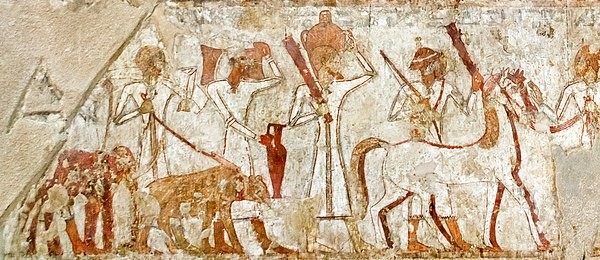
Egypt has an unusually hot, sunny and dry climate. Average high temperatures are high in the north but very to extremely high in the rest of the country during summer. The cooler Mediterranean winds consistently blow over the northern sea coast, which helps to get more moderated temperatures, especially at the height of the summertime. The Khamaseen is a hot, dry wind that originates from the vast deserts in the south and blows in the spring or in the early summer. It brings scorching sand and dust particles, and usually brings daytime temperatures over 40 °C (104 °F) and sometimes over 50 °C (122 °F) in the interior, while the relative humidity can drop to 5% or even less.
Prior to the construction of the Aswan Dam, the Nile flooded annually, replenishing Egypt’s soil. This gave Egypt a consistent harvest throughout the years. Egypt’s hot and arid climate is increasingly strained by climate change, leading to extreme temperatures, droughts, floods, and rising sea levels. As a highly vulnerable nation, these environmental shifts threaten food security, water availability, public health, and economic stability.
Economics
Egypt’s industrial base is diverse, encompassing chemical production, electronics, mining, steel, automotive manufacturing, pharmaceuticals, and textiles. The chemical industry is one of Egypt’s largest, comprising plastics, rubber, paper, detergents, paints, fertilizers, and glass. Petrochemicals alone contribute around 12% of industrial output, valued at approximately $7 billion annually.[202] With projected exports of $9 billion in 2024, the government supports the sector through infrastructure development, technology investments, and trade agreements.
Egypt’s agricultural sector remains essential to its economy, though its share of GDP and employment has declined over time. Egypt produces substantial quantities of wheat, maize, sugarcane, fruits, vegetables, fodder, and rice, yet remains reliant on wheat and maize imports, primarily from Ukraine and Russia, despite yield improvements since 1970. This dependency stems from high domestic demand, driven by subsidies and a culinary preference for bread, as well as Egypt’s limited arable land and its emphasis on high-value export crops. The Aswan High Dam, completed in 1971, significantly improved irrigation stability. As of 2010, 3.6 million hectares were cultivated, with the government targeting 4.8 million hectares by 2030. Major initiatives include the New Delta and Toshka Project, designed to convert desert areas into farmland using advanced irrigation techniques, wastewater treatment, groundwater and water desalination. Efforts to deregulate agriculture have improved price alignment with global markets, but climate change and water scarcity continue to pose long-term challenges.
Tourism is one of the most important sectors in Egypt’s economy. 2024 saw a record 15.7 million tourists, surpassing 14.9 million in 2023. This growth, driven by government efforts to enhance security and tourism support, reflects a strong recovery from the pandemic-induced decline of 2020. Tourism revenues have also surged, reaching $14.1 billion, reflecting steady improvement over previous years.[220] Egypt’s tourism strategy aims to attract 30 million tourists by 2028, with a focus on infrastructure improvements, high-profile projects like the Grand Egyptian Museum, and enhancing visitor experiences. In 2024, the country’s top tourism markets included Germany, Russia, and Saudi Arabia.[220] The Giza Necropolis is one of Egypt’s best-known tourist attractions; it is the only one of the Seven Wonders of the Ancient World still in existence.






